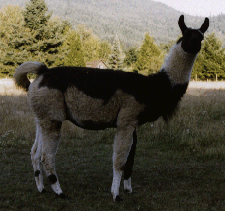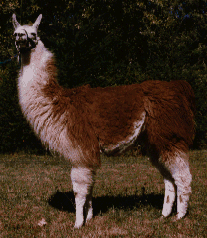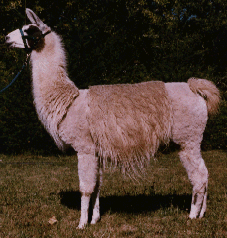Llama care, management and resources
- Llama FAQ
- Llama literature
- Basic care
- Castration
- Spaying
- About breeding llamas
- Handling young llamas
- Misdirected territorial aggression
- How old should llamas be for training and work?
Fiber from llamas
Llamas
as guardians
Classic performance llamas
Communicating
Our llama family
Just for fun
Cria photos
Training consultation
Performance
llama analysis
If you don't rescue ... DON'T BREED!
If you don't rescue ... DON'T BREED!
If you don't rescue ... DON'T BREED!
If you don't rescue ... DON'T BREED!
If you don't rescue ... DON'T BREED!
If you don't rescue ... DON'T BREED!
Thermal
regulation in working llamas - phase two
Gwen Ingram
Part one of this study was conducted in 1991, and a preliminary report was published in the June 1992 issue of The Backcountry Llama.
Our 1996 study was structured primarily to assess the relative effectiveness of partial shearing and full body shearing. Although we had limited access to llamas with certain fiber characteristics, we were fortunate that variations in the llamas selected allowed at least two llamas representing any given pertinent feature to be compared with at least two dissimilar llamas. As a result, we could compare the effects of wool density on both shorn and unshorn llamas.
We selected six llamas: Llamas A and C both had coarser fiber with lower density and open chest, and llamas B and D had finer fiber with higher density and wool closure over the chest. Control llamas E and F both had coarser fiber with lower density and open chest area and were selected because of previously proven successful thermal regulation. Llamas A, B, and E were moderately overweight. Llamas C, D, and F were in good condition. All llamas had been completely combed out the previous year.
Llama A:
- 8 years
- gelded male
- white with <5% orange
- 4.5" wool fiber length, moderate density, open; 32.0 microns average with 16.1 microns SD
- 45"/344 lb
Llama B:
- 5 years
- gelded male
- black with est 25% white
- 5" wool fiber length, high density, full wool closure; 25.4 microns average with 10.1 microns SD
- 45"/352 lb
Llama C:
- est 6 years
- gelded male
- orange with <20% white
- 5.5" wool fiber length, low-moderate density, open; 32.3 microns with 16.7 microns SD
- 42.5"/237 lb
Llama D:
- 10 years
- gelded male
- white with <5% black
- 4.5" wool fiber length, high density, moderate wool closure; 24.7 microns with 9.1 microns SD
- 43.5"/309 lb
Llama E (control):
- 12 years
- intact male
- black
- 4" wool fiber length, low-moderate fiber density, open; 29.2 microns average with 12.9 microns SD
- 43.5"/318 lb
Llama F (control):
- 8 years
- intact male
- grey with <20% white
- 6" wool fiber length, low fiber density, open; 36.5 microns average with 18.4 microns SD
- 44.5"/282 lb
Fiber density was first estimated by hand (subjective comparison of relative force necessary to compress the living fleece). Total fiber from the four shorn llamas was later weighed, raw data corrected for total fiber length, and amount of fiber removed, and a figure was derived allowing direct comparison of density between fleeces. The subjective hand estimation correlated in all cases with the mathematically derived figures.
Fiber samples were submitted to Yokom-McColl testing laboratories for determination of average fiber diameter and standard deviation.
Heights were measured with the llamas standing on concrete and using a four-foot leveling device. This method yields repeatable data accurate to within .125".
Weight was recorded at the end of the study using a digital electronic scale. Weights were rounded to the nearest pound and were not corrected for probable feed and water intake fluctuations.
Procedure:
All six llamas first contributed at-rest baseline data in the morning before rising and in the hottest part of the afternoon. Ambient temperature, location, position (standing or kushed), and activity level were noted. Humidity measurements were unavailable, but relative assessments were recorded.
Following accumulation of baseline data, overweight llamas A and B were shorn over approximately 50% of their bodies to an average length of 1.5-2". Densely-fibered llama B was shorn in a "barrel cut" pattern (a current fad); moderately-fibered llama A was shorn with the reverse: a "muscle cut." After further at-rest data collection, the remaining fleece from both llamas A and B was removed, and final data were collected.

Above: Llama B with full body cut plus belly shave
Llamas C and D participated in postexertion temperature recovery studies. Following initial body temperature readings, each llama ran with a handler for one mile. Both llamas were run consectutively by the same handler to eliminate data contamination by different running speeds and weather conditions. Llama temperatures were then recorded every five minutes for one hour postexertion. One run was conducted in the evening (with cooling conditions), and two runs were conducted mid-day.
Llamas C and D were then shorn in the same patterns as llamas A and B, but to an average length of 1.25." This time, moderately-fibered llama C received the "barrel cut" and densely fibered llama D received the "muscle cut." Again, pasture data were collected, followed by postexertion data collection conducted in the same manner as when llamas C and D were in full fleece.


Above left: Llama C with "barrel cut"; Above right: Llama D with "muscle cut"
After pattern-shorn postexertion data collection, llamas C and D were fully shorn. At-rest and postexertion data collection were again repeated in the same manner.
To complete the study, densely-woolled, "closed," and "hot" llamas B and D's undersides were shaved to the skin and at-rest data recorded. Then, "hot" llama D and control llama E were combed out and final at-rest temperature data on all six llamas were recorded.
At-rest body temperatures
Initial data were taken in moderate weather with an average ambient morning temperature of 48° and an average ambient afternoon temperature of 68°. Initial results showed that llamas B and D (whose only common features are dense wool and wool closure) were consistently hotter by an average of 1° in the morning and .5° in the afternoon.
After barrel cuts and data taken at comparable ambient temperatures, llamas B and C were still hotter by an average of .5° in the morning, but both were insignificantly different from the controls in the afternoons (although dense-wooled llama B was in fact consistently hotter than llama C). However, both of the controls were markedly more active and were often in the sun; llamas B and C were more often standing in the shade. Compared with data taken in full fleece, dense wooled llama B was cooler (.3° average), but llama C was not significantly different.
After muscle cuts and data taken at comparable ambient temperatures, llamas A and D had average morning temperatures identical to the controls; however, both were hotter than the controls in the afternoon by an average of .4°. Compared with data taken in full fleece, dense-wooled llama D averaged a full degree cooler than before, but llama A showed no significant changes.
All partially shorn llamas either posted their coolest temperature or initially moved to a substantially warmer location the morning after shearing. Also, all partially shorn llamas began to seek shelter during rainstorms after shearing. Although we anticipated such behavior based on previous results (1991), the change was abrupt and unexpected given the moderate rainfall amounts. Llama B, densely wooled and with the greatest amount of fleece remaining (2 inches) proved least likely to seek shelter by several days postshearing.
After full body cuts, morning and afternoon temperatures for the shorn group did not differ significantly from those taken when partially shorn, either as averages or when compared individually. This is significant in light of the markedly hotter weather (average ambient morning temperature 55°; average ambient afternoon temperature 96°). The shorn group was slightly hotter than control llama F (control llama E's data had to be discarded because he was markedly more active in the pasture than the rest of the group). Despite the heat, llama C began to preferentially spend afternoons in the sun rather than the shade after being fully shorn, which is also a significant behavioral change.
After belly shaves, llamas B and D posted their lowest individual morning temperatures up to that time, but with no change in afternoon temperatures. Unlike postshearing, both llamas B and D did not have lower temperatures initially, but they showed a steady decrease over the course of several days. This implies that wool closure affects the ability of a llama to disperse heat during the night and thus has a cumulative effect in increasing body temperature.
After combing (llama D and control llama E only), the group as a whole had very similar temperatures for both morning and evening except for uncombed, dense-wooled llama B, whose average morning temperature was still .7° above the group average and .5° above the next highest of the group (llama D). Llama B's afternoon temperatures were comparable, but he was less active. Combed-out llama D became markedly more active at this time and also spent more time in the sun.
In summary, it is apparent that densely-wooled llamas benefit significantly from shearing, but that llamas with moderate to low-density fleeces do not benefit significantly at rest. Any shearing -- partial or full -- did result in habit changes and obvious discomfort during inclement weather. Full-body shearing proved superior to partial shearing for heat dispersal at rest. Finally, fiber length did not prove to be an important factor in heat retention (the coolest llama of the group also had the longest fiber), but fiber fineness still appears to play a contributing role in that fine fiber is necessary to maximize density.
Postexertion temperature increase and recovery
Initially, llamas C and D were run in full fleece at an average ambient temperature of 92°. Dense-wooled llama D began hotter than llama C and also proved to be comparatively inferior in postexertion heat dispersal. After one markedly humid run, llama D's temperature continued to climb rapidly to reach a potentially dangerous level, and so he was cooled and data were discarded from that run.
Llama C then received a barrel cut and llama D received a muscle cut. Three days postshearing elapsed before running to allow body temperatures to stabilize. The average ambient temperature was cooler (75°), and so data were directly comparable only between llamas and not with data taken in full fleece. Despite the unfortunate difference in ambient temperatures, it was clear that llama D benefited more from his muscle cut than did llama C from his barrel cut during exertion. However, the muscle cut was markedly inferior to the barrel cut for postexertion cooling.
Both llamas C and D were then fully shorn to 1.25" of fiber. Again, three days postshearing elapsed before running to allow body temperatures to stabilize. The average ambient temperature was 84°.
With identical sheared areas, dense-wooled llama D's statistics were once again contoured similarly to llama C's, but the overall average temperatures were as proportionately inferior as when both llamas were in full fleece, with one exception: llama D now dispersed significantly more heat (1.1° compared with .5°) postexertion with his full body cut. Overall, llama C gained little by being fully shorn and did not benefit as much as did llamas who were combed out (including llama D) in the 1991 study. Llama D did not benefit as much from shearing as from combing but did benefit significantly when fully shorn.
Summary
The 1996 data clearly showed that a llama who is cooler when at pasture will also be cooler after exertion. As in the 1991 study, individually considered and averaged data again fully support that wool fineness and density -- not fiber length -- play the primary roles in heat retention. Llamas with lower fiber density (natural or acquired) and coarser fiber consistently managed heat better. Those llamas also benefited comparatively little from shearing; dense, fine-fibered llamas benefited most from a combination of shearing and combing.
The 1996 data also showed conclusively that
when dense-wooled llamas are shorn with the objective of attaining
adequate heat dispersal both during and after exertion in warm
to hot weather, the entire body should be shorn (1-1.5"
remaining), the belly shaved to the skin, and the remaining fleece
should be combed out as well. Observation of the study llamas'
behavior as well as data taken in mildly inclement weather during
the 1996 study indicates that provisions should be made to adequately
shelter and protect shorn llamas from the elements.
This report originally appeared in The Backcountry Llama, April 1997, and appears here with the permission of the author. Reproduction in any form is prohibited without the express written consent of the author. Address permission requests to: llamaprints@att.net
Copyright © 1997 by Gwen Ingram. All rights reserved.
Return to Research
Return to Lost Creek Llamas home page